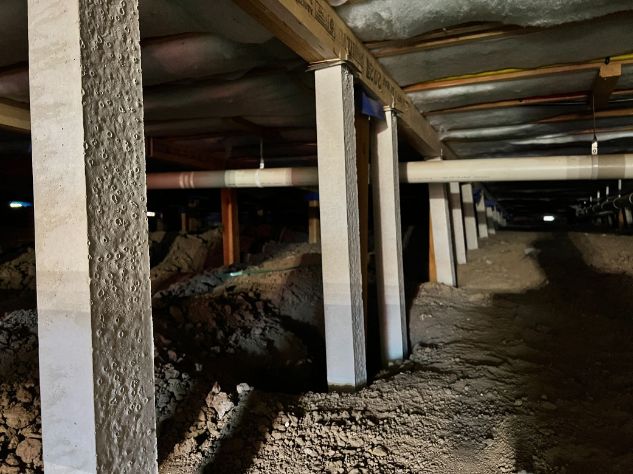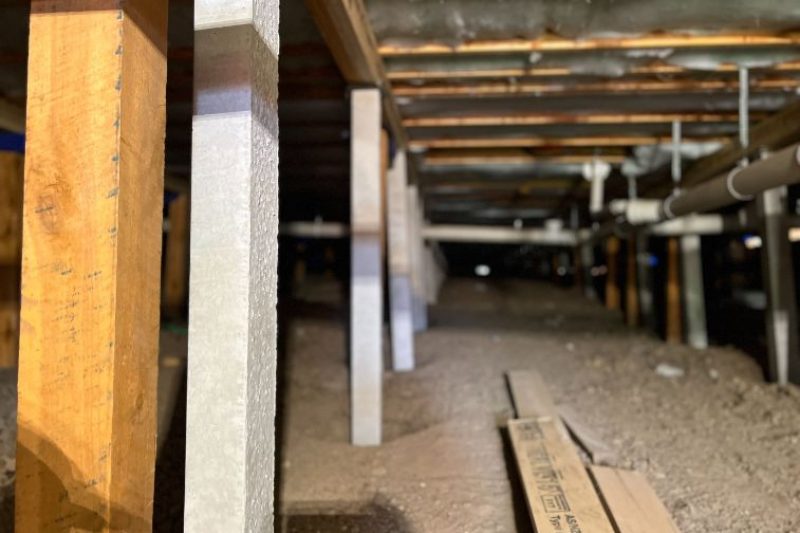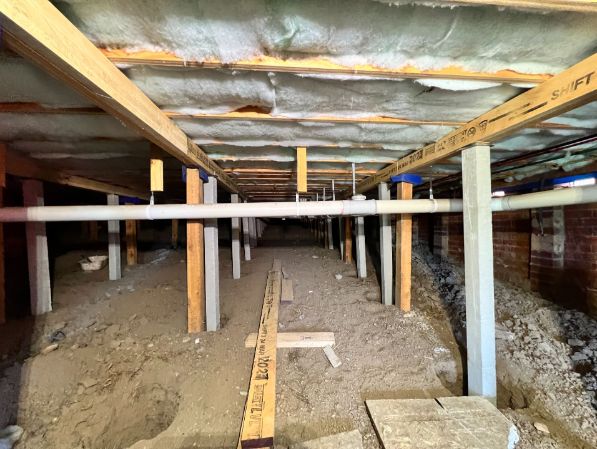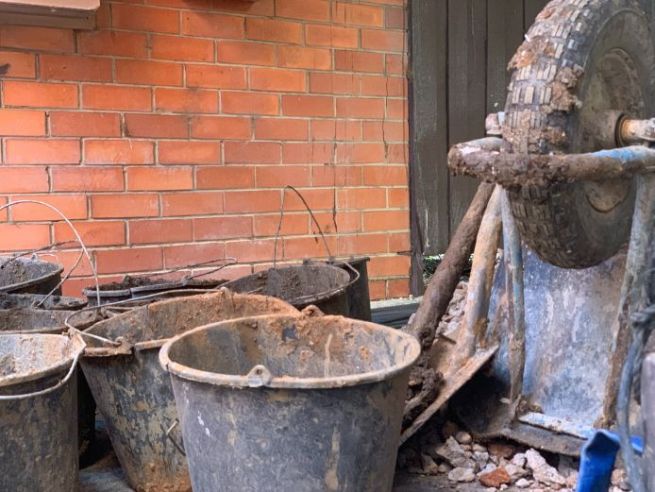Restumping Geelong | House Reblocking Services | Master Builder
✅ 10 year guarantee
✅ Shortest lead Time - Largest Team
✅ Master Builder Certified
✅ Fully Licensed Builder
✅ All Council Requirements handled
Start with a Free quote!
"*" indicates required fields
House Restumping Reblocking Experts in Geelong
Our Technicians Use Tried And Tested Techniques To Minimise The Impact Of The Restumping Project On Your Family’s Daily Routine.
If you’ve noticed sagging in your floors, doors no longer shutting or opening, then get in touch with our team today and get a free assessment of your property from the professionals at Geelong Restumping Solutions
We are the leading provider of restumping services in Geelong, offering residents solutions that keep their homes safe from structural damage.
Our experts will begin by carrying out a thorough assessment of your home, checking the condition of your stumps as well as the floor. We will then discuss with you an optimal solution for your stumping challenge, ensuring your problem is solved for the long-term at a competitive price.
Our highly experienced technicians make restumping Geelong houses as quick and unobtrusive as we possibly can. In a short amount of time, you will be able to enjoy a safer, more comfortable residence.
From start to finish, our team will update you on the project’s progress, making sure you’re kept in the loop throughout the foundation repair process. It’s our communication and attention to detail that sets us apart. We always ensure that we keep the site clean and safe during and after the reblocking process.
Go to the gambling site Casino Joy and win at gambling online at the site of the most popular gambling club in Russia. Dreaming of getting rich from the comfort of your own home? Try your luck in gambling, playing on the official site of Casino Joy.
What is Restumping?
Over time, the stumps that hold a house could suffer damage, possibly as a result of rotting or being attacked by termites. Even concrete stumps, known for their strength and longevity, can crack and fall apart, compromising the integrity of your home’s structure. Restumping is the process of removing and replacing such stumps fully or partially. Left unattended, damaged stumps will not only cause uneven floors, but lead to foundational damage and the eventual collapse of your home.
At Geelong Restumping Solutions, we only use concrete and steel stumps and install ant caps on all of our stumps. This maximises termite protection for the structure of your home and ensures that when the job is completed, we won’t be back again. If you’re wondering are restumping and underpinning the same then this article will answer your questions.
Do I Need Restumping?
Houses will generally have two types of foundation: a concrete slab or stumps made of either timber, concrete or steel. If your house has the former, you will not require reblocking. Problems with slab foundations are usually addressed by underpinning. However, if your house is built on stumps which have lost their integrity, restumping is how you restore the structure of your property.
There are some telltale signs you can look out for to see if stumps are damaged, short of a full building inspection. If you have noticed that your floor doesn’t feel level or your doors are not closing properly, your house may be due for restumping. Cracks on the outer or inner sides of your walls are another sign of this.
Give us a shout for affordable restumping in Geelong. We will be waiting to get to work and restore your home to the structurally sound, safe abode you know and love.
What’s the Difference Between Restumping and Reblocking?
The terms restumping and reblocking are used interchangeably to refer to the same procedure of replacing damaged stumps in order to restore the integrity of a building’s foundation. Both refer to the process of replacing stumps of a building by placing jacks below the structure of the floors, lifting the building enough to remove the problem stumps and replacing them for new ones. The new stumps are then fixed with concrete and the jacks are removed when the concrete sets.
There is another procedure performed to repair structural damage in a house’s foundation known as underpinning. It is mentioned in the same breath as restumping and reblocking, but it is not entirely the same.

Get in touch with us for a free consultation.
"*" indicates required fields
How do I Know if I Need Restumping or Underpinning?
The main difference between restumping and underpinning is what footing system your house has been built on. If your house has been built on a suspended floor then you will require reblocking. If your house has been built on a concrete slab, then you will require underpinning. This is because when a concrete slab is used as the footing system, there are no stumps required.
We working closely with a team of underpinning contractors that have been underpinning Geelong homes successfully for years. We’re able to work closely with them when there are projects that require both reblocking and underpinning.
Get in touch with Geelong west leading team and we will be able to help determine whether or not it’s likely underpinning or to get restumped. Our technicians will conduct an assessment of your house; from its walls to its foundation. Their findings will determine which solution is best for your house for the long-term, all while helping you save on the restumping cost.
How do I tell if my house has been built on a suspended floor?
One of the best things to look for is whether or not there are plinth boards surrounding your house. If you can see that there is crawl space below your floors, then your house is built on suspended floors. Ducted floor heating and ducted vacuum systems are all signs that your house is built on stumps. Looking from the outside of your house, you may notice that your floors are raised off the ground, indicating that your property is built on stumps.
If you can see there that there is no space between your floors and the ground, or your house has a brick veneer, then it is likely that your house is built on a concrete slab. In this case, if your property has experienced cracking in the wall tiles, uneven floors and issues opening windows and doors, or you have noticed significant cracks in the external brickwork of your house, then you will need to contact an underpinning contractor. So whether you’re in Bendigo, Torquay, Lara, Melbourne, Werribee, Melton or Sunbury, our restumping team are there to help.
Why do Stumps Deteriorate?
We’ve seen that damaged stumps will require you to make plans for restumping and sometimes you’ll need to be replacing brick piers under house to bring your house back to level. But just what causes the stumps beneath your house to lose their integrity?
Weather:
Insects:
Termites and some ant species are known to eat up timber stumps and can be quite problematic in some parts of Australia. However, these troublesome insects may not be a reason your Geelong property may need reblocking. They are less common in these parts. To be on the safe side, though, you can prevent possible damage to your timber stumps by insects using pest control measures.
Age:
No matter what material your stumps are made of, they will still suffer wear and tear over time. Steel, concrete or timber, stumps will weaken and lose their structural integrity as the years pass. How well the stumps can hold up against rust, concrete cancer, the weight of the house, insects and the prevailing weather conditions will determine how long they will last. Stumps can last for up to 80 years in ideal conditions but it’s wise to conduct a building inspection from time to time to forestall major damage. Our restumping experts will check your foundation for any signs of cracking and recommend the most cost-effective solution.
Soil:
Wet soil is not good for your stumps. If you have problems with drainage in the vicinity of your house or any plumbing issues that are causing leakages, it’s wise to get them addressed as early as possible. Dark patches around your stumps could be a sign that they’re standing in excessively moist soil. This dampness can eventually lead to subsidence.
Subsidence happens when the foundation of your house slowly sinks into the ground because the soil can no longer support its weight. Excess moisture is just one of the causes of this. Being surrounded by moisture-hungry plants that suck up all moisture from the soils beneath them is another. A house built on land that used to be a quarry can also be a cause for concern in this regard. The type of soil is another; clay soils being particularly notorious for causing subsidence.
Besides moisture, the type of soil in your locality may affect the stability of your stumps. A number of homes in Geelong have to undergo reblocking as they are built on fill or reactive clay. A foundation built on this kind of soil will eventually need repairs as reactive soils easily expand and contract depending on the amount of moisture around them. It’s important that we use concrete stumps Geelong soils can deal with, not timber stumps that won’t last.
Call us today for a complete assessment of your home to begin the process of reblocking your Geelong Vic residence. Our license technicians have completed several projects in the port city and its environs and are best placed to handle the intricacies of its geology. With us you are guaranteed solid workmanship that will stand the test of time.
The Restumping Process
Restumping essentially entails removing defective, damaged, and cracked stumps from a house’s foundation and replacing them with new ones. Simple as it may sound in theory, it is an involved process that ordinarily takes anywhere between a couple of days to two weeks to complete. Before the actual works commence, you will need to get all the necessary documentation in place, beginning with a building application permit. Prior to this, your chosen contractor will have carried out all the required assessments to get a clear idea of the extent of the reblocking. Once you have obtained all the necessary approvals from a registered building surveyor, the reblocking experts can get on the ground.
Another key preliminary measure to take is determining the datum point of the house. This is a point of reference that will be used when levelling the floor. If restumping is being done as part of a larger renovation exercise, it’s important to get in a restumping contractor early on to ensure that the house is levelled prior to painting, plastering and other tasks.
From start to finish, your home is in safe hands when using our house restumping geelong team as we’re fully insured. Get in touch to organise an obligation free quote today.
Steps For House Restumping In Geelong
Here’s an overview of how the restumping process plays out:
Get your restumping Geelong project off the ground with experienced experts who have completed numerous similar projects in the region. With us, you are guaranteed sterling workmanship that will last you for many years to come. Contact us today for a building inspection and a free quote.
Restumping FAQs
The cost of restumping a house in Geelong will typically be between $4,000 and $15,000. But pricing is not one-size-fits-all; the cost will depend on the following:
- The size of your house
- The number of stumps that need replacement.
- What type of stumps will be used. The options are steel, concrete and timber. Galvanised steel stumps are the most expensive option while timber stumps will cost you the least.
- How accessible the stumps are. Is there access below the floors that our team can easily get through? The time spent trying to access the stumps can vary the price.
- Condition of the timbers below the floor. If the bearers and joists have rotted then they will have to be replaced.
Cheap is expensive. Tempting as it may be, don’t simply opt for the service provider who offers you the lowest price. This can end up costing you dearly in the long run as you may have to redo shoddy work or work done with inadequate, or low-quality materials. By using trusted house restumping reblocking professionals like Geelong Restumping Solutions, we’ll always ensure high standards of quality workmanship. Always ensure you use a contractor who has experience in restumping Geelong.
Yes, you will require a building permit and there are a number of documents you will need to submit along with your application for a permit. They include the following:
- Site location plan
- Certificate of Title and subdivision plan
- Builders homeowners warranty insurance
- Geotechnical/ Soil report
Your application will need to be accompanied by a building permit application fee. When you call Geelong Restumping Solutions for a free assessment, our team will be able to provide you with all the information you need to apply for a permit and the process you should take.
Majority the time, yes. If you have noticed your house keeling in one direction or sinking, you will want to know if it can be restored to its original height. And it is wise to get help as soon as you notice this instability as it may lead to long-term damage to the structure of your house. In most cases where you have suspended floors, the culprit is usually defects in the stumps at the base of your house. The situation can be remedied by engaging contractors like our team, which has spent years reblocking Geelong properties, to replace the defective stumps. The extent of the damage the stumps have suffered and the soil which holds your foundation will determine the best solution.
We’ve found that restumping projects can be finished in roughly three to five days. However, if your project merely involves replacing some damaged stumps, it could even take less. The precise number of days to finish your foundation repairs will depend, to a large extent, on the size of your house and the level of access we have. If we are able to begin the project and have access throughout the property, the timeline will decrease.
Restumping should be the first step in your home improvement exercise as your house sits on the stumps. Extensive renovations will often require you to remove floorboards and pull down walls. It, therefore, only makes sense to start with the restumping to avoid repeat work. The last thing you need when you have finished renovating your home is for your freshly painted walls to begin cracking when the house is raised to become level. By restumping your house prior to renovating you’ll also give your walls the best chance of being straightened ready for tiling or hanging doors.
Get in touch with us today and find out what affordable professional restumping in Geelong looks like.
Relevelling floors is something that may be new to the majority of people. Here we will talk about what those relevelling floors are when it comes to Restumping , in a way that may help you better understand the subject.
We restump for many reasons, one such reason being because there are high spots on your floor. Another reason is because of a dip in your floor, which causes uneven rooms and doors. When you have uneven doorways it`s not only hard to get through, but also causes damage to the trim and wall as well as the door frame.
Relevelling floors is one way to fix these problems. It isn’t an easy task, but with the right knowledge and training, it can be done.
You want to make sure that you don`t get someone who is not qualified or properly trained to restump your home because of what could happen. There are many dangers when it comes to this job, so it would be best for you if you stayed safe and got someone who knows what they are doing.
How do i know if i need restumping geelong?
Here are some things to look for when accessing whether you need reblocking
Посети официальный сайт Jozz Casino, чтобы получить бонус +100% к сумме первого депозита. Потому регистрация Jozz Casino это уникальная возможность получить бонус и разбогатеть, играя в азартные игры онлайн.




